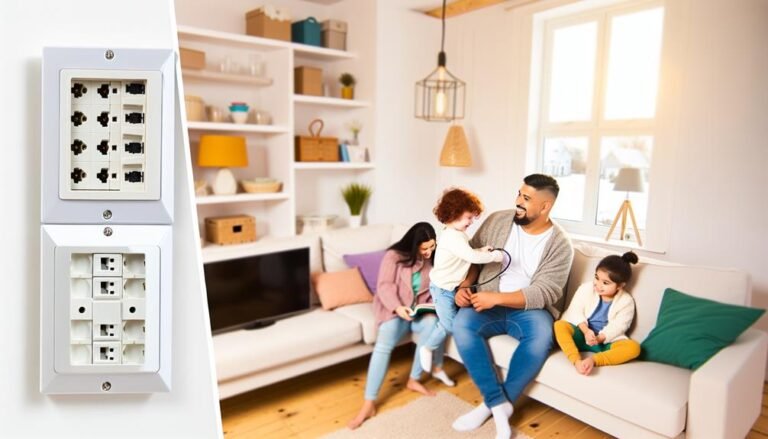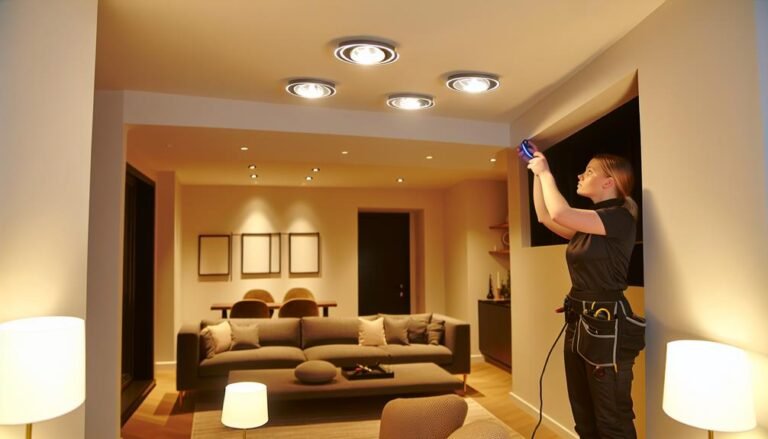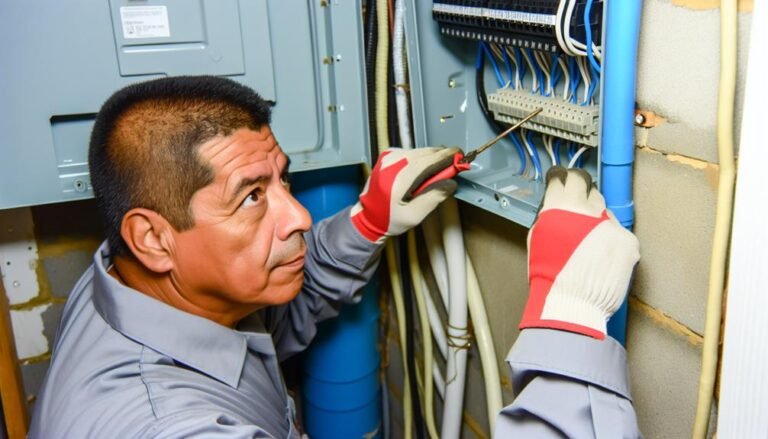Smart Home Electrical Upgrades: A Residential Electrician’s Perspective
Imagine stepping into a world where your home is not just a place to reside, but an intelligent companion that seamlessly adapts to your needs. Like a skilled conductor orchestrating a symphony, a residential electrician’s perspective on smart home electrical upgrades can illuminate the path to a harmonious and technologically advanced living space.
But how do these upgrades truly transform your home? And what crucial considerations must be made to ensure a smooth transition into this realm of modernity?
Prepare to embark on a journey through the eyes of a residential electrician, where the possibilities are electrifying and the rewards are illuminating.
Key Takeaways
- Hiring a professional electrician is essential for smart home electrical upgrades due to their specialized knowledge and skills.
- Evaluating the existing electrical system is crucial before implementing smart upgrades, including assessing the capacity and condition of the electrical panel and wiring.
- Proper wiring installation and circuit breaker selection are important to ensure electrical safety and optimal performance.
- Thorough research, proper placement, and correct installation of smart home devices are necessary for integration and optimal performance.
Importance of Hiring a Professional Electrician
When it comes to electrical upgrades for your smart home, it’s of utmost importance to hire a professional electrician. Smart homes are equipped with advanced technology that requires specialized knowledge and skills to install and maintain.
A professional electrician has the expertise to handle complex electrical systems and ensure that the installation is done correctly and safely. By hiring a professional electrician, you can have peace of mind knowing that your smart home’s electrical upgrades are in capable hands.
They’ll assess your home’s electrical needs and recommend the best solutions for your specific requirements. They’ll also ensure that all wiring and connections are up to code, reducing the risk of electrical hazards such as fires and electrical shocks.
Additionally, a professional electrician will provide you with valuable advice and guidance throughout the process. They can help you choose the right smart devices and make sure they’re compatible with your home’s electrical system. They can also offer tips on energy-efficient practices and help optimize the performance of your smart home.
Evaluating the Electrical System for Smart Upgrades
To properly upgrade your smart home’s electrical system, a thorough evaluation of the existing infrastructure is necessary. Before you can begin adding smart devices and automation features, it’s important to assess the capacity and condition of your electrical system. This will ensure that your home can handle the increased load and that the necessary upgrades are made to meet the demands of a smart home.
Start by examining your electrical panel. Determine if it has enough available circuit breakers to accommodate the new devices you plan to install. Look for any signs of wear or damage, such as rust or loose connections, which may indicate the need for repairs or replacements.
Next, evaluate the wiring throughout your home. Check for outdated or inadequate wiring that may not be able to support the power requirements of smart devices. Consider upgrading to modern wiring, such as copper or aluminum, to ensure optimal performance and safety.
Additionally, assess the electrical outlets and switches in your home. Determine if they’re compatible with smart devices or if they need to be replaced with smart-enabled versions. Look for any signs of wear, such as loose or cracked outlets, which may pose a safety hazard.
Ensuring Proper Wiring and Circuit Breaker Installation
To ensure proper installation of wiring and circuit breakers in your smart home, it’s crucial to follow industry standards and guidelines for electrical safety. Wiring is the foundation of your smart home’s electrical system, carrying the electrical current throughout the house. It’s essential to use the correct type and gauge of wire for each circuit to prevent overheating and potential hazards.
Additionally, it’s important to install circuit breakers that match the wire size and rating, providing protection against overcurrent and short circuits.
When wiring your smart home, ensure that you use copper wiring as it’s a reliable conductor and has excellent electrical properties. Aluminum wiring, although cheaper, can cause potential safety issues due to its higher electrical resistance and increased risk of overheating.
To ensure the proper functioning of your smart home’s electrical system, it’s recommended to hire a licensed electrician who’s the expertise and knowledge to perform the installation according to local codes and regulations.
When installing circuit breakers, it’s vital to choose the appropriate size and type for each circuit. The circuit breaker protects the wiring from overloading and can quickly shut off the power in case of a short circuit, preventing electrical fires. It’s crucial to select circuit breakers that match the wire size and rating to ensure the safety of your smart home’s electrical system.
Choosing and Installing Smart Home Devices
You can ensure a seamless integration of smart home devices by carefully selecting and installing them according to manufacturer instructions and compatibility guidelines.
Here are three key steps to consider when choosing and installing smart home devices:
- Research and Compatibility Check: Before purchasing any smart home device, thoroughly research its features, compatibility, and integration with your existing smart home system. Check if it supports the communication protocol used by your other devices, such as Wi-Fi, Zigbee, or Z-Wave. Also, ensure that the device is compatible with your smartphone or voice assistant for easy control.
- Proper Placement: Proper placement plays a crucial role in the performance of smart home devices. Consider factors like signal strength, range, and interference. For example, Wi-Fi-based devices should be placed within range of your router, while devices like smart thermostats should be installed away from direct sunlight or drafts to accurately detect temperature.
- Follow Manufacturer’s Instructions: Always follow the manufacturer’s instructions for installation. This includes connecting wires correctly, mounting devices securely, and configuring settings as per the provided guidelines. Failure to follow instructions can lead to malfunctioning or even safety hazards.
Testing and Maintenance of Smart Home Electrical Upgrades
After successfully choosing and installing your smart home devices, the next step is to ensure proper testing and maintenance of your smart home electrical upgrades.
Testing your smart home system is crucial to ensure that all devices are functioning correctly and communicating with each other effectively. It’s recommended to perform regular tests to identify any potential issues or malfunctions.
Start by checking the connection between your smart devices and the central hub or control panel. Ensure that all devices are receiving power and that the connections are secure. Test each device individually to verify its functionality and responsiveness.
Additionally, check for any software updates for your smart devices and make sure to install them promptly.
Maintenance of your smart home electrical upgrades involves keeping the devices clean and free from dust or debris. Regularly inspect the wiring and connections to detect any signs of wear or damage.
It’s advisable to consult a professional electrician for routine maintenance and inspections to ensure the longevity and efficiency of your smart home system.
© 2025 By Electrician Phoenix






